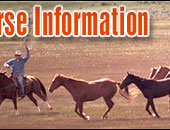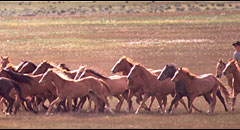 |
   |
|
|
|
You are here: Horses > Horse diseases > Horse Arthritis |
Causes of Equine Arthritis in Your Horse
The first signs are subtle. You might have noticed a slight
limp, or a suggestion of lameness that might be invisible to
others who donít know your horses as well as you do. You ask
your vet to evaluate your horse, and the diagnosis returns
as arthritis. |
|
|
Arthritis is a condition that is similar in both humans and
horses. However, it can certainly impact how you interact
with your horse from now on. Osteoarthritis, also called
degenerative joint disease or DJD, is one of the leading
causes of lameness in horses. It is a group of joint disorders, most frequently involving
the hocks, front fetlocks, and the coffin joints and
navicular bones of the front feet. Understanding how
arthritis affects the joints is easier when you know how a
normal joint functions. |
In a healthy joint, the bones fit closely together. The ends
of the opposing bones are cushioned by a thick layer of
rubbery material called cartilage. It not only protects the
ends of the bones from grinding together and being damaged,
it acts like a natural shock absorber to help absorb the
impact from the horseís weight hitting the ground with each
step. It also provides a slick, frictionless surface for the
ends of the leg bones to rub against as the horse walks,
trots, and runs. The joint itself is composed of the tough,
fibrous outer capsule and the inner synovial membrane.
 Collateral ligaments surround and connect the bones, their
strong bands providing both protection to the joint and
stability in motion. The joint cavity is filled with a
thick, lubricating fluid. This thick, pale yellow fluid is
called synovial fluid, and it bathes the joint whenever the
horse moves. This synovial fluid is crucial to healthy
joints, because it lubricates the jointís soft tissue and
provides nourishment to the cartilage, which does not have a
blood supply of its own. This is also why damaged cartilage
often does not heal well. Collateral ligaments surround and connect the bones, their
strong bands providing both protection to the joint and
stability in motion. The joint cavity is filled with a
thick, lubricating fluid. This thick, pale yellow fluid is
called synovial fluid, and it bathes the joint whenever the
horse moves. This synovial fluid is crucial to healthy
joints, because it lubricates the jointís soft tissue and
provides nourishment to the cartilage, which does not have a
blood supply of its own. This is also why damaged cartilage
often does not heal well.
Synovial fluid is made of large molecules of hyaluronic
acid, tangled together to form a thick barrier that prevents
inflammatory cells from gaining entrance to the joint. These
molecules are a basic need for healthy joints.
When a joint is subjected to repeated stress or trauma, such
as can occur with everyday riding, training, or racing, it
often leads to damage of the synovial membrane and joint
capsule. At this point, lameness is not always present.
However, as the damage worsens, the horse becomes lame and
the joint becomes hot and swollen. The damage to the tissue
allows white blood cells to escape nearby blood vessels and
invade the joint space.
These white blood cells then release destructive substances
which start to degrade the jointís cartilage. Enzymes from
the white blood cells also begin to break down the
hyaluronic acid molecules. This results in synovial fluid
that is thin and watery, and has poor cushioning and
nourishing qualities. If left untreated, the joint damage
progresses to arthritis and, eventually, degenerative joint
disease that can become crippling.
Once it has been damaged, the cartilage does not heal well.
Since it does not have a blood supply of its own and must
depend on the synovial fluid, which has also been degraded
by the inflammatory process, the cartilage often does not
repair itself at all. Once DJD is established, there is no
way of curing it. It can be managed, but often leads to a
horseís premature retirement. Sometimes, horses with severe
DJD must be put down.
 |
Read the next horse diseases article on Equine Infectious Anemia. |
|
|
|
|
 |
|
|
|
|
|
Horse Education
|
|
|
|
|
Horse Information Topics
|
|
|
|
|
|
|
|
Horse Business Owners
|
| |
Advertise with Us
Have your horse products or services exposed to over 27,000 of our monthly visitors.
|
|
|
|
|
|